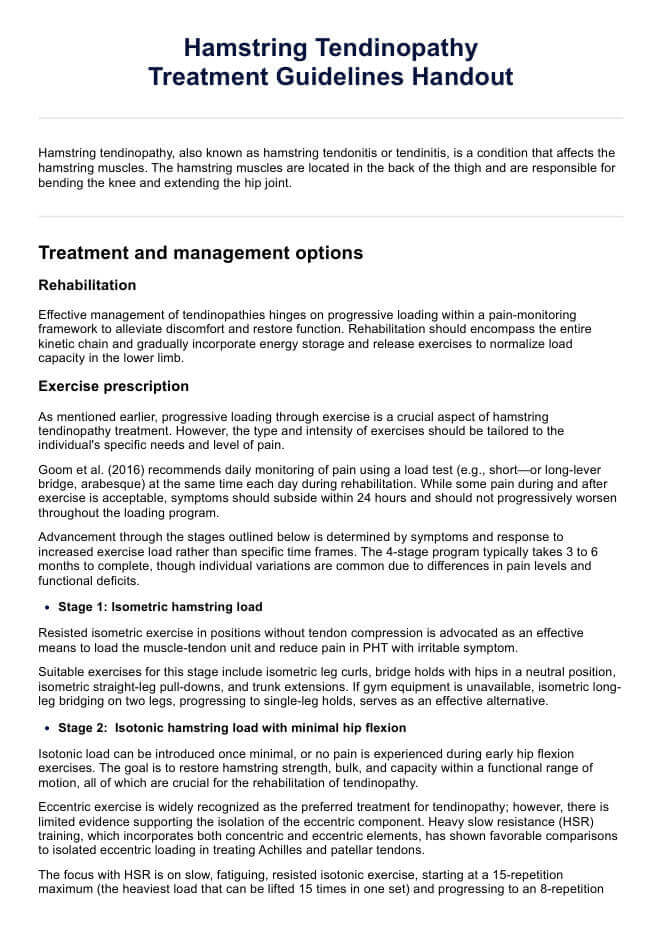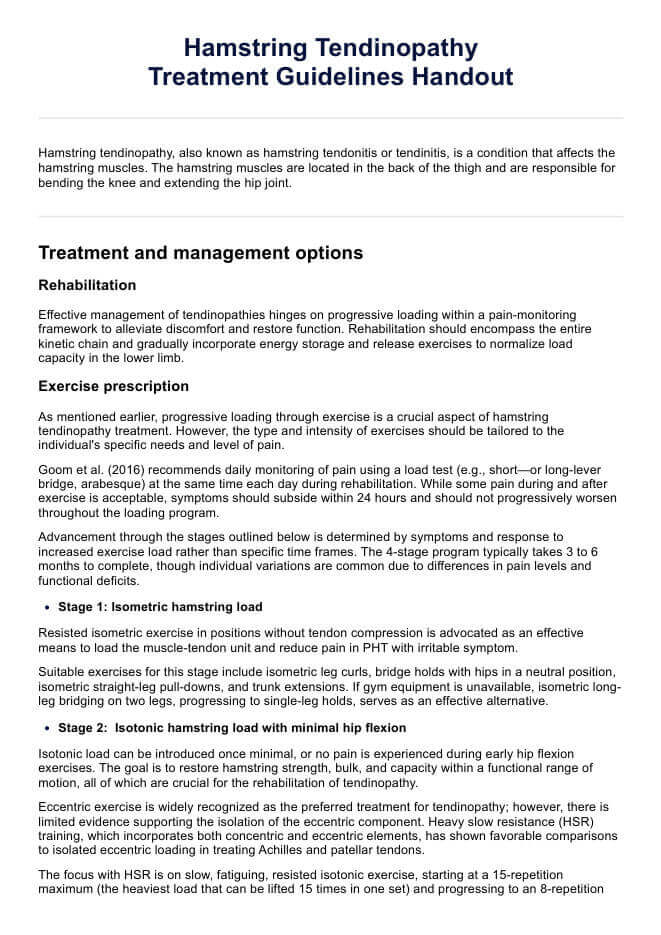Hamstring Tendinopathy Treatment Guidelines Handout
Learn about hamstring tendinopathy and how it's treated. Download a free PDF template for your clinical practice.


What is hamstring tendinopathy?
Hamstring tendinopathy, or proximal hamstring tendinopathy, presents a challenge characterized by persistent tendon pain near the ischial tuberosity where the hamstring muscles attach. This condition isn't just about discomfort; it affects athletes—think track stars and soccer players—and active individuals, especially those under 40. The underlying pathology mirrors other tendon issues with collagen disruptions, increased matrix presence, and new blood vessel growth.
Clinically, it manifests as pain in the lower gluteal area, worsened by activities like running or sitting for long periods. Diagnosis hinges on a detailed history and physical exam, pinpointing tenderness over the ischial tuberosity, often aided by imaging such as MRI or ultrasonography for confirmation (Lempainen et.al, 2015).
Hamstring Tendinopathy Treatment Guidelines Handout Template
Hamstring Tendinopathy Treatment Guidelines Handout Sample
How to manage and treat hamstring tendinopathy
Managing and treating hamstring tendinopathy requires a combination of rest, rehabilitation exercises, and proper training techniques:
Rest
The first step in managing any injury is to give the body time to rest and heal. This means avoiding any activities that aggravate the hamstring tendon.
Exercise progression
Once the initial pain and inflammation have subsided, it is important to gradually reintroduce exercises that strengthen the hamstring muscles. This should be done under the guidance of a physical therapist or qualified trainer. The progression of exercises should be slow and steady, increasing in intensity and difficulty over time.
Eccentric strengthening exercises
Eccentric strengthening exercises involve lengthening the muscle while it contracts, which has been proven to be effective in treating tendon injuries. These types of exercises can include eccentric leg curls, squats, and deadlifts.
Foam rolling and stretching
Foam rolling can help to release tension and tightness in the hamstring muscles, which can contribute to tendinopathy. Stretching exercises can also help to improve flexibility and range of motion.
Proper training techniques
Many cases of hamstring tendinopathy are caused by overuse or improper training techniques. It is important to listen to your body and not push through pain during workouts. Gradually increasing intensity and incorporating rest days into your training schedule can also help prevent future injuries.
Other treatment options
In addition to exercise and rest, there are other treatment options that may be beneficial in managing hamstring tendinopathy. These include:
- Anti-inflammatory medication: Non-steroidal anti-inflammatory drugs (NSAIDs) can help to reduce pain and inflammation.
- Physical therapy: A physical therapist can assist with developing a personalized exercise plan and providing manual therapy techniques to aid in healing.
- Corticosteroid injections: In severe cases, corticosteroid injections may be recommended by a healthcare professional to reduce pain and inflammation.
- Surgery: In rare cases where conservative treatments have not been successful, surgery may be necessary to repair the damaged tendon.
What is a Hamstring Tendinopathy Treatment Guidelines Handout?
A Hamstring Tendinopathy Treatment Guidelines Handout provides structured recommendations for managing and treating proximal hamstring tendons conditions. The handout details non-surgical treatments such as isometric and isotonic strengthening exercises to alleviate tendon pain and improve function.
Healthcare professionals, including orthopedic surgeons, physiotherapists, and sports medicine physicians, can utilize this handout to guide treatment decisions and educate patients on rehabilitation protocols. It is particularly useful in clinical settings where hamstring tendinopathy occurs frequently, helping to standardize care and optimize patient outcomes. The handout is recommended for use during initial consultations and throughout the rehabilitation process to ensure comprehensive management tailored to individual patient needs.
How to use our treatment guidelines handout template?
Our treatment guidelines handout template for proximal hamstring tendinopathy provides a structured approach to managing and treating conditions like severe tendon tear and hamstring tendonitis. Healthcare practitioners can utilize this resource effectively by following these steps:
- Accessing the handout: Log in to Carepateron and navigate to the template section where the treatment guidelines handout template is available for download.
- Initial assessment: Perform a thorough evaluation of the patient's symptoms, including deep buttock pain and posterior thigh pain, to confirm the diagnosis of proximal hamstring tendinopathy.
- Implementing treatment protocols: Follow the step-by-step recommendations outlined in the handout to initiate treatment protocols aimed at reducing pain and improving function through exercises and modalities.
- Monitoring progress: Regularly assess the patient's response to treatment, adjusting protocols as needed based on their improvement and any sciatic nerve involvement.
- Patient education: Educate the patient about the condition, treatment options, and expected outcomes to ensure they actively participate in their recovery.
By following these steps, healthcare professionals can effectively utilize our treatment guidelines handout template to provide optimal care for patients with proximal hamstring tendinopathy and related conditions.
Benefits of using this handout
Our handout for proximal hamstring tendinopathy offers healthcare providers several key benefits:
- Comprehensive guidance: It provides a structured approach to managing conditions like high hamstring tendinopathy and hamstring muscle injuries, ensuring thorough treatment planning.
- Evidence-based recommendations: Based on current musculoskeletal medicine practices, it incorporates effective treatments such as eccentric exercises and heavy slow resistance training to target affected tendon and surrounding muscle.
- Reduction of pain: By outlining protocols to reduce pain and relieve inflammation associated with tendon complaints, it aims to improve patient comfort and function.
- Patient education: It educates patients about their condition, including the potential involvement of the sciatic nerve and complete proximal hamstring avulsions, fostering better understanding and compliance with treatment plans.
- Enhanced treatment outcomes: By promoting the use of modalities like extracorporeal shockwave therapy and ensuring proper management of hamstring origin tendinopathy, it supports improved patient outcomes and faster recovery times.
Using our handout empowers healthcare providers with the tools needed to effectively treat proximal hamstring tendinopathy, enhancing patient care and satisfaction while adhering to best practices in musculoskeletal medicine.
Reference
Lempainen, L., Johansson, K., Banke, I. J., Ranne, J., Mäkelä, K., Sarimo, J., Niemi, P., & Orava, S. (2015). Expert opinion: diagnosis and treatment of proximal hamstring tendinopathy. Muscles, Ligaments and Tendons Journal, 5(1), 23–28. https://www.ncbi.nlm.nih.gov/pmc/articles/PMC4396672/
Commonly asked questions
Treatment includes both conservative and advanced interventions. Conservative approaches focus on reducing pain and inflammation through rest, physical therapy (including eccentric exercises), and modifying activities. Advanced treatments may include corticosteroid injections or, in severe cases, surgical repair.
Eccentric exercises, such as the Nordic hamstring exercise, have shown effectiveness in rehabilitating hamstring tendons by improving tendon structure and strength. These exercises are integral to the rehabilitation process, aiming to restore function and reduce pain.
Consider referral to a specialist if conservative treatments fail to alleviate symptoms, if there is suspicion of a severe tendon tear, or if the patient's condition requires advanced interventions like platelet-rich plasma injections or surgical consultation.







































































































